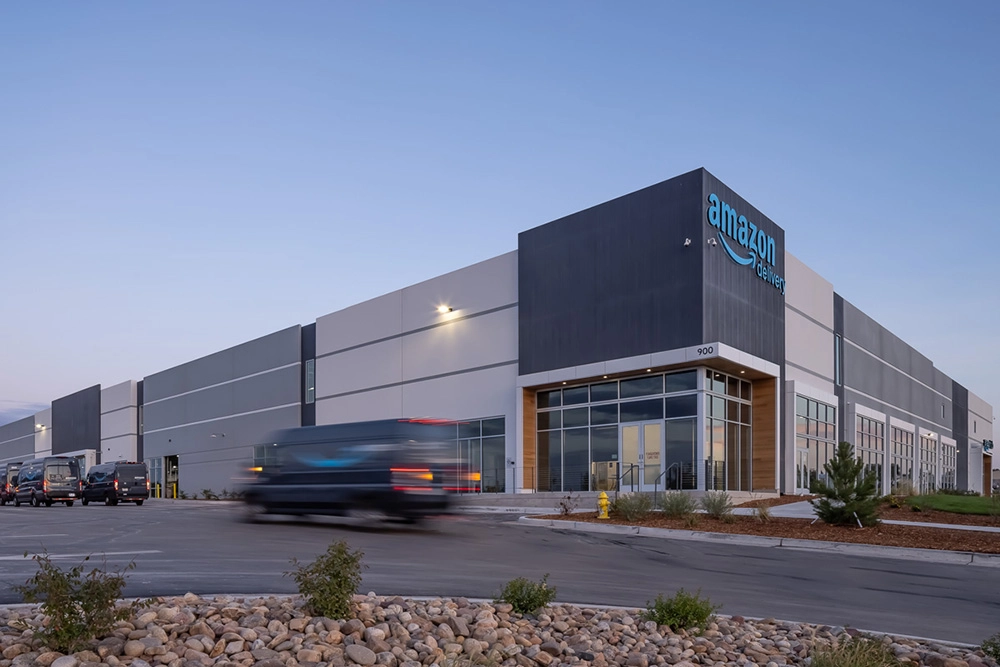Delivering for Clients While Bringing Value to Communities
We aim to go beyond – not only by delighting our clients and the users of our buildings but also by caring for the communities where we build these projects.

We aim to go beyond – not only by delighting our clients and the users of our buildings but also by caring for the communities where we build these projects.
“We are genuinely concerned about how our projects look on the outside,” said Jay Fourniea, Director of Architecture. “We ensure we meet the city's requirements or exceed them with additional features that represent our clients’ brands. This ties directly to our mission to exceed our client's expectations and empower their missions through the buildings we deliver.”
Our relentless commitment to getting this right was illustrated when we customized a speculative industrial building for an e-commerce client.
E-commerce at North Washington Commerce Center
To expedite delivery to their customers’ doorsteps, many e-commerce businesses use last-mile facilities. Often established in smaller, infill buildings near residential neighborhoods, the facilities are customized to efficiently receive, sort and deliver goods.
To compete in the complex and evolving world of e-commerce, retailers need to get last-mile facilities up and running fast. Many have found customizing well-located speculative industrial buildings works well. Expediting the process hinges on enlisting developers and design-builders who can deliver quickly.
That’s exactly what happened at North Washington Commerce Center in Thornton, Colo., just five miles from Denver.
Our team had completed the 151,200-square-foot building in August 2019. In February 2020, an e-commerce user signed a long-term lease for the building and chose our team to build-out a last-mile facility, as well as to design and construct a large three-story parking garage.
Navigating Entitlements with the City
The building is surrounded by homes and businesses, so traffic levels and aesthetics were of primary concern to the city.
“The City of Thornton is meticulous. Getting through entitlements and approvals takes a good amount of time,” Fourniea said. “But that would have been counterproductive to what our user needed.”
Our one-team model enabled a fast turnaround for the client while satisfying the needs of the city and other local stakeholders.
“Our designers worked directly with our real estate developers and their consultants to expedite processes with the city,” said JR Reynolds, Director of Project Management. “We are all working toward the same goal and presenting a unified plan.”
“Our existing relationships with the city staff made it easier to navigate through complexities on behalf of our client," Fourniea said. "That could have been a challenge for many others.”
Design to Benefit the Community
Last-mile e-commerce operations generate a lot of activity. Waves of inbound trucks and outbound sprinter vans are coming and going.
“The city had strict zoning ordinances for screening activity, as well as style and quality of architecture,” said Nick Mann, Project Manager. “We worked with them to arrive at solutions that worked for the neighborhood and the client. Our developers and designers played a huge role in getting the project through city approvals and entitlements.”
“The entitlement process required finesse and close communication with the city,” said Sean Cummings, Vice President of Real Estate Development. “We addressed their concerns with traffic mitigation and management, as well as earthen berms and other screening systems.”
“We met strict city guidelines for glazing on the building and the quality and finish of the architecture,” said Fourniea. “And we integrated additional features like specialized high-speed roll-up doors that are both aesthetically pleasing and practical for the user.”
The three-level, 700+ stall parking structure provided site circulation relief and created a safer environment for the user’s operation, local traffic and pedestrians.
Our one-team model with development, design and construction experts enabled quick assessment and pivoting to meet the needs of the city and the client. As requirements evolved, our designers expedited proof of concept drawings, schedule and budget impacts, while our developers outlined any potential city challenges on the entitlement side.
“Community concerns are important to us,” said Fourniea. “We care what neighbors living nearby see and experience, as well as people who drive or walk by the building.”
Article Type: Blog Post
Topics: Denver | Design Services | Development | Construction


